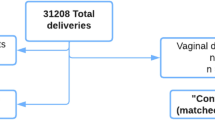Abstract
Introduction and hypothesis
This study aimed to evaluate any differences in the incidence of perineal trauma in women undergoing vaginal delivery following intrauterine fetal death (IUFD) versus live-births. This information would be of interest in evaluating the possible effect of fetal demise on the mechanism of labour in the second stage and thus may provide invaluable insights to contribute to our understanding of the impact of fetal tone on the mechanics of labour and delivery.
Methods
323 women who delivered vaginally following IUFD were matched with 1,000 women with a live-birth for age, parity, gestation and birth weight. Women undergoing assisted vaginal delivery and/or episiotomy were excluded.
Results
Women with an IUFD had a significantly lower risk of perineal trauma overall (relative risk 0.16) as well as a lower risk of obstetric anal sphincter injury specifically (RR 0.12).
Conclusions
Women delivering vaginally after IUFD have a lower incidence of perineal trauma compared with women delivering a live infant. This may be due to differences in biomechanics following an IUFD.

Similar content being viewed by others
References
Magann E, Chauhan S, Bofill J, Waddell D, Rust O, Morrison J (2001) Maternal morbidity and mortality associated with intrauterine fetal demise: five year experience in a tertiary referral hospital. South Med J 94:493–495
Ifnan F, Jameel M (2006) Maternal morbidity and mortality associated with delivery after intra-uterine fetal death. J Coll Phys Surg Pak 16:648–651
Cheng Y, Hopkins L, Caughey A (2004) How long is too long: does a prolonged second stage of labour in nulliparous women affect maternal and neonatal outcomes? Am J Obstet Gynecol 191:933–938
Raisanen S, Vehvilainen-Julkunen K, Gissler M, Heinonen S (2009) The increased incidence of obstetric anal sphincter rupture- an emerging trend in Finland. Prev Med 49:535–540
Ashton-Miller J, Delancey J (2009) On the biomechanics of vaginal birth and common sequelae. Annu Rev Biomed Eng 11:163–176
Parente M, Natal Jorge R, Mascarenhas T, Fernandes A, Silva-Filho A (2010) Computational modelling of approach to study the effects of fetal head flexion during vaginal delivery. Am J Obstet Gynecol 203(217):E1–E6
Lien K, Mooney B, DeLancey J, Ashton-Miller J (2004) Levator ani muscle stretch induced by simulated vaginal birth. Obstet Gynecol 103:31–40
Conflicts of interest
None.
Author information
Authors and Affiliations
Corresponding author
Rights and permissions
About this article
Cite this article
Basu, M., Mukerji, S. & Doumouchtsis, S.K. Perineal trauma in women undergoing vaginal delivery following intra-uterine fetal demise: a case–control analysis. Int Urogynecol J 25, 61–64 (2014). https://doi.org/10.1007/s00192-013-2148-1
Received:
Accepted:
Published:
Issue Date:
DOI: https://doi.org/10.1007/s00192-013-2148-1




